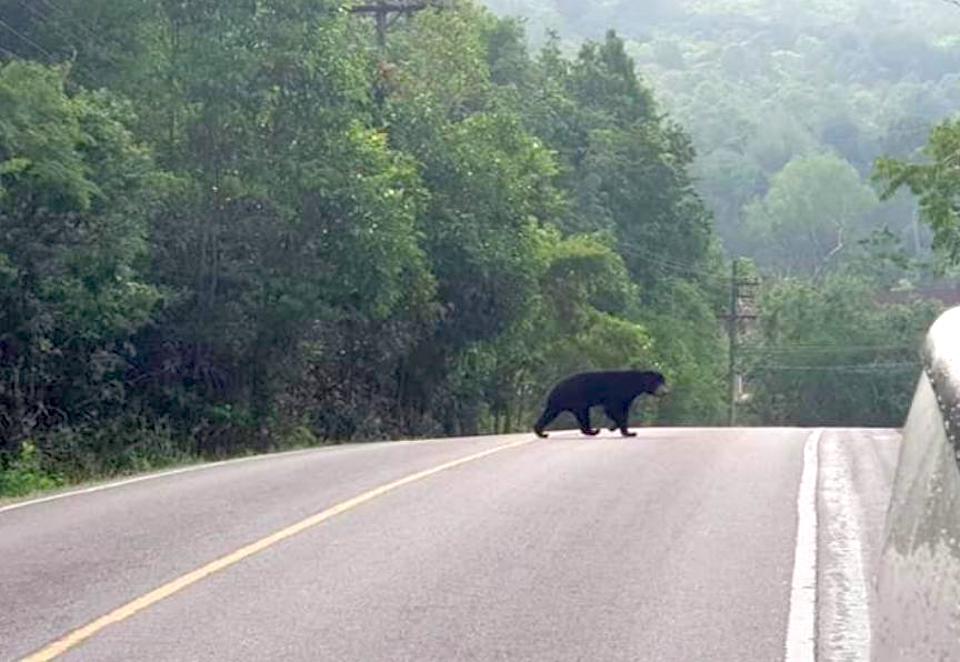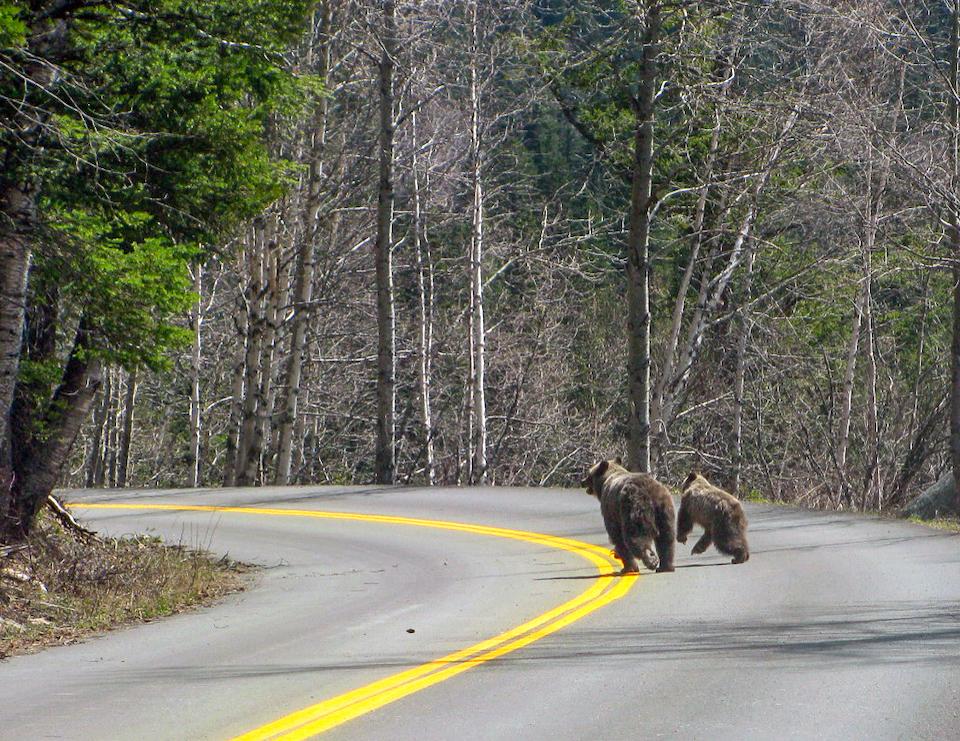
A sun bear in Khao Yai National Park/Thailand Department of National Parks, Wildlife and Plant Conservation
In Thailand, officials want to close their national parks every year for two months or so to give wildlife a break from humans. Would that fly in the United States? While it might make sense for a variety of reasons, would the National Park Service, the politicians, the gateway towns, and park travelers agree to such a move?
Accompanying a news report of the Thai proposal by Varawut Silpa-archa, the country's minister of National Resources and Environment, was a photo of a sun bear, a usually reclusive animal, crossing a road in Khao Yai National Park.
"The absence of tourists leads to wildlife recovery," Thanya Netithammakun, director-general of Thailand's Department of National Parks, Wildlife and Plant Conservation, told the Bangkok Post.
Would such a closure be good for wildlife in the U.S. National Park System? There have in recent weeks been reports about wildlife in parks such as Yosemite and Death Valley being spotted in places usually filled with visitors. But Park Service officials in Washington say the behavior really isn't unusual.
"The NPS Office of Communications has been in consistent contact with the natural resources staff in Fort Collins (Colorado) and with parks including Yellowstone, Joshua Tree, Rocky Mountain, Acadia, Great Smoky Mountains, Everglades, and Death Valley over the last couple of months regarding this topic," Park Service spokesperson Kathy Kupper told Traveler last week.
"And the basic answer we receive is what you read -- that really, the only noted difference is that some wildlife have used open roads to travel and some have been seen foraging for food in areas they generally shy away from when people are present. An example is from Joshua Tree National Park where desert tortoise were seen crossing roads from which they usually stay away. Coyote and fox also left 'their mark' on the once busy park roads."
While pronghorn antelope at Death Valley have been seen at lower elevations than normal, that can't be tied to the coronavirus pandemic because those sightings began two years ago, said Kupper.
Still, research has shown that wildlife generally avoid humans, and will return to areas once humans have left. A 2013 study at Yellowstone National Park found that "human occupancy of (backcountry) campsites can displace (grizzly) bears from habitats up to 400 meters away and that campsite closures may enhance foraging opportunities for grizzly bears."
Anecdotal evidence has backed this up, as the situation at Yosemite has demonstrated and from photos taken by road crews in Glacier National Park earlier this month.

Grizzly bears spotted by road crews crossing the road in Glacier National Park/NPS
Should anyone be surprised that wild animals will return to areas they were driven out of by humans, once those humans are gone?
Along with allowing such wildlife movements through annual closures of parks for a month or two, closures could allow entire landscapes to "rest" a bit without humans. Give campgrounds an extra eight weeks to recover even just a little bit from being pounded down by campers. Ditto with some trails where crowds of hikers have widened the intended footprint of a path. Keep park maintenance staff employed and allow them to catch up on their park's backlog without visitors.
Plus, perhaps some wildlife would begin to regain a little bit of its fear of human visitors and the wouldn't be as many human-wildlife conflicts once the humans were let back into parks.
That's simply said, but such closures in the United States very likely wouldn't be quickly embraced.
"I am pretty sure that the U.S. visitors and businesses would not be in favor of closing parks for two months unless the NPS employs an effective education program and even then, it would be a long process before this type of proposal would likely be accepted," said Phil Francis, chair of the Coalition to Protect America's National Parks. "I think it's an idea worth considering and if it's implemented in Thailand, then the NPS should learn from it to determine its effectiveness."



Comments
Not a bad idea, but of course a full roster of LE rangers would be required to collect up all the poaching fools who would poke their unwanted heads up. I would guess that it would be a differeent time in different parks also.
Hi Everyone,
I have a question before I buy an RV. When a Park says that he limit is 40 feet including the truck, can I just park a 24 foot trailer there and park the truck somewhere else? Then I am under the 40 foot restriction? Or does the truck length have to be included for me to get a spot? I really hope the answer is that I can park the truck somewhere else.
Thanks,
John
[email protected]
This is actually an important and timely topic in a number of respects. We know and are pretty constantly discussing how the overcrowding in our national parks negatively impacts visitors' experiences and, frankly, public health and safety. Traffic is usually horrendous; parking is often as bad as or worse than in any urban area; there are packed lines at food services; campgrounds are beaten down and filthy; and restroom facilities are frequently unsanitary and disgusting. High visitor loads overwhelm the infrastructure and the staffing levels in many, if not most, parks and, although it doesn't help that the GOP chronically and habitually obstructs proper funding for the parks, visitor numbers would still exceed the basic carrying capacities in many parks even if they did receive proper funding. I know the nincompoops in the crowd want to blame it all on the excessive number of foreign visitors; but, that's more a reflection of their bigotry than any sincere concern for our parks.
However, while we selfishly focus on how this overcrowding and overuse impacts our visiting experience, we don't pay as nearly as much attention to it's impact on the natural environment that led to the "protection" of most of our parks in the first place. Recently observed changes in wildlife behavior certainly show that wildlife is also negatively impacted by the crowds and the overuse, as if we didn't already know it.
I certainly agree that "visitors and businesses would not be in favor of closing parks" for actually more than a minute due to the culture of selfishness and greed that we have coddled and cultivated over the years; but, that culture of selfishness and greed should not be reinforced, appeased, or even tolerated. Of course, closing the parks for whatever period is necessary to maintain and protect them is "an idea worth considering" and, as far as the NPS needing to employ an effective education program is concerned, the NPS has been needing to employ an effective education program in a lot of areas for a very long time so there's no news there. I also agree that we need to maintain "a full roster" of LEOs; but, again, we've already been needing that for a long time as well.
With regard to whether parks should be closed for a couple months each year to give them a respite from human traffic, I strongly agree with the intent, but believe it's a more complex question. First, each park should comprehensively and objectively establish its basic carrying capacity, along with the factors that drive that capacity. Second, each park should establish a reservation system that reflects and enforces its basic carrying capacity. Third, each park should have the authority to close and remain closed for any period, a couple of years if necessary, and for any reason, including wildlife protection, needed to maintain and protect the park, its resources, its staff, and the public. Fourth, each park should be able to tailor and use its downtime to repair, maintain, restore, or protect as it sees fit, without political appointees, concessionaires, other special interests, or "visitors and businesses" interfering. A park may need to close a particular scenic or recreation area to clean and repair facilities or to protect plants that need to seed or to enable wildlife to breed, rear young, or feed on a seasonal resource and such closures should be under the authority of the park's resource protection teams, without outside interference. Finally, we have sunk to a new low with the appointment and influence of folks who have no background in resource management over our public lands. Park's need to be managed by folks who have backgrounds, including formal education, in park and resource mangement. Today, however, DOI, NPS, USFS, BLM, park nonprofit, and concessionaire management is full to overflowing with oil and gas lobbyists, failed and former oil and gas managers trying to be lobbyists, mining and extractive industry retreads, GOP legal minions, marginally literate ranchers trying to be GOP minions, lesser children of once prominent GOP minions, NRA activists, corporate "spin" specialists, marketeers looking for an opening, overslicked real estate scammers, and even a guy with a degree in petroleum engineering who spent his career specializing as a "greenwasher" for aging GOP politicians. This is not what park management should be and we need to change it as soon as we can.
This is definitely worth considering. Periodic closures of national parks would clearly benefit wildlife. However, there would be major pushback from tourism-related businesses, which would be a difficult political problem to overcome.
We need to greatly expand the number and geographic distribution of parks for many reasons. One benefit would be that sceduled closures could be done while still offering people alternative parks to visit.
Colombia does this as well https://colombiareports.com/colombias-tayrona-national-park-close-month-...
Typically the limit in length is because of some limit inside the park. This could be tight turns or how the pull-offs are setup for vehicle usage. If there is a limit, the only option would be to drop your trailer outside the park somewhere and then drive your vehicle through the park before returning to pick up your trailer afterwards.
YES. A RESOUNDING YES. THEY SHOULD BE CLOSED FOR 3 MONTHS!
That was funny!!My adult family and I, who are active hikers, enjoy the National Parks every year. Last year it was Yellowstone and Grand Teton, it's not bigotry to say that for visitors are clogging the parks, they should be allowed in on a permit basis. We experiences the same issues in Zion and Grand Canyon. They photobomb your photos of iconic landscapes and have horrible trAil etiquette. And I know, the liberal scapegoat is always the GOP. Please......